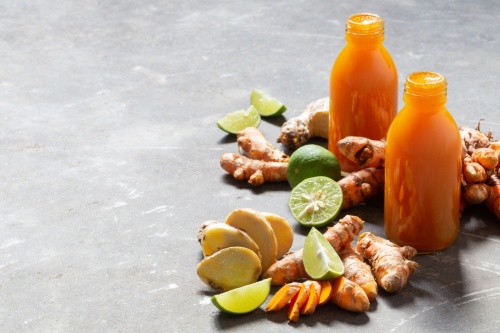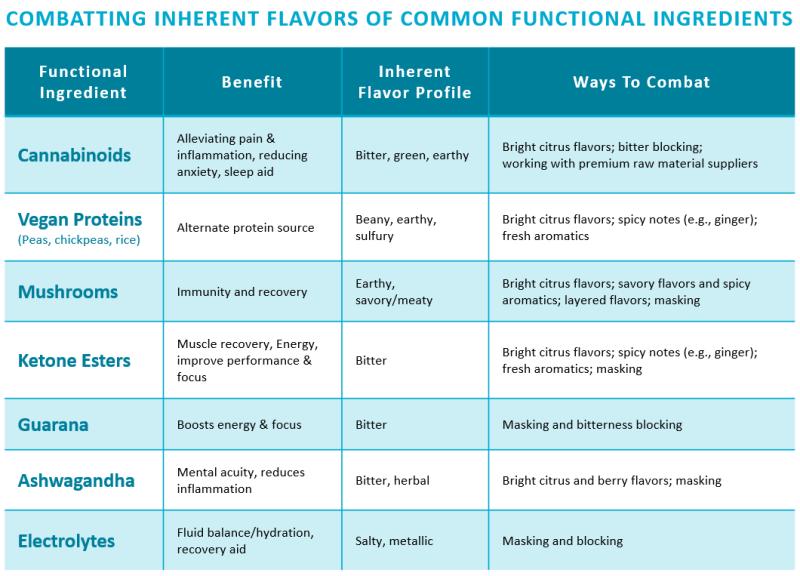Overcoming Flavor Challenges When Formulating A Functional Beverage

Formulating a successful functional beverage can be challenging. Not only does your product need to deliver the desired functional claim, such as energy, focus, or relaxation, but it also needs to taste good and keep consumers coming back for more.
With every functional ingredient added to a formula at meaningful levels, there is the potential to introduce off-flavors such as bitterness, earthiness, or metallic aftertastes, to name a few. A formulation expert can take your kitchen recipe and commercialize it into a shelf-stable liquid that balances function and taste.
Finding the correct balance requires expert knowledge to address the technical challenges of incorporating functional ingredients into a liquid while using flavors to balance, counteract or mask offensive or unwanted notes.
Formulators creating a functional beverage have three go-to tools in their flavor arsenal:
- Leaning into the inherent flavor(s) of your functional ingredients
- Using flavor maskers and blockers
- Working with ingredient suppliers that have “cleaner” tasting alternatives
Leaning into the Flavor Profile
Many functional ingredients have strong, distinct flavor characteristics that can easily overpower other flavors in a formulation. Leaning into or complementing those flavors can make it easier to create a balanced, great-tasting beverage.
For example, peas and pulses are gaining popularity as a versatile source of plant-based protein, but they have earthy notes that may not be desirable. While adding a stronger flavor to “overpower” the offending notes may be tempting, it can throw a flavor profile off balance.
A better approach is to work with instead of against the offending ingredient. Bright, natural flavors such as citrus or ginger complement the earthy notes of pea protein and successfully bridge the gap between an unpalatable ingredient and a great-tasting beverage.
But what do you do when working with an ingredient such as amino acids, which have a naturally “sulphury” note? While those notes may not be off-putting in a savory application, they would be unacceptable in a sports drink.
For these situations, product formulators look to block or mask unpleasant flavors by modifying the perception of the undesirable notes.
Maskers and Blockers: Flavors with Modifying Properties
Masking and blocking agents offer beverage formulators another option: suppressing unwanted notes, such as bitterness, or modifying the perception of these notes.
Masking is when formulators use an ingredient to introduce an aroma and/or taste attribute that modulates or “masks” our perception of off-notes. Maskers can include ingredients such as sweeteners and acids. Used correctly, they are applied at levels that create a neutral flavor profile; overuse may result in adding an unintended flavor attribute (e.g., “too sweet”).
Blocking changes the taste attribute of an offending ingredient by either “binding” with it or by “blocking” it from the taste receptors on our tongue.
Ketone Esters are functional ingredients that are gaining popularity in many markets but have a taste similar to spoiled milk, requiring flavor technology to block the offensive flavors before formulators can incorporate them into a palatable beverage.
Working with the Right Ingredient Supplier
Flavor and ingredient suppliers are aware of the many challenges posed by working with functional ingredients and are constantly working behind the scenes to provide formulators and brand owners with cleaner-tasting base ingredients and forms to work with.
Cannabinoid beverages are a great example. Over the past few years, cannabinoid-enhanced beverages have exploded on the market. Still, many cannabinoids, such as CBD, present formulation challenges. CBD isolate is inherently very bitter, and CBD emulsions can have very green notes. Ingredient suppliers have been working on this issue and have made tremendous progress in quality and taste. Formulators can help brand owners identify suppliers with cleaner-tasting products and/or use a masking system to make their products palatable. Ingredient suppliers may also offer alternative solutions such as a citrus-derived CBD, which has a cleaner taste than traditional CBDs because it doesn't have the terpenes that give hemp-derived CBD its grassy, earthy taste.
Here are some commonly-used functional ingredients and ways to combat their inherent, undesirable flavors:

Other Considerations
With the increased consumer demand for clean labels and natural ingredients, many brand owners are leery of harnessing the beneficial power of “flavors” when creating their functional beverages. If a clean label or natural claim is desired, formulators can help brand owners prepare for functional ingredient taste challenges with a variety of vetted flavor options available to address them. Formulators can help brand owners choose flavors that will successfully allow them to deliver the desired taste and functionality while still permitting them to make clean and natural claims.
Natural flavors also have these additional benefits that brand owners should keep in mind when formulating their drinks:
- Flavors can provide your functional beverage with much-needed flexibility within the confines of consumer trends, manufacturing requirements, regulatory restrictions, and supply chain constraints. For example, flavors add flexibility when brand owners want to incorporate natural juices into a beverage formula. While juices can diminish in flavor over time, supplementing juices with more stable natural flavors or extracts opens options for extending your beverage’s shelf life.
- Working with flavors or extracts to supplement juices can also build resilience into your supply chain and lower your raw ingredient and shipping costs.
- Incorporating flavors can help lower sugars. Consumers are keen on reducing sugar, but great taste and indulgence still play an important role in beverage enjoyment.
Consumers are increasingly demanding functional beverages as a convenient, portable format that delivers the wellness solutions that they seek. But it’s not just about the benefits. Consumers also expect every drink they purchase to taste good. Creative formulators use various tools to address the technical and flavor challenges that arise when working with functional ingredients. The result is a flourishing, flavor-filled functional beverage category.
Reach out to learn how BevSource can help you create a functional beverage with optimal flavor.
 By
By 